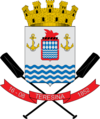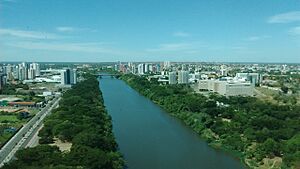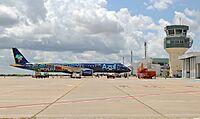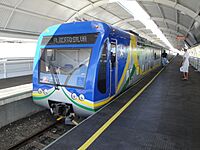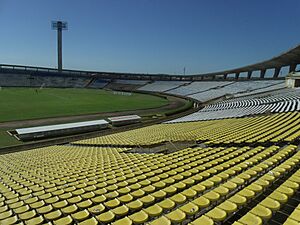Teresina facts for kids
Quick facts for kids
Teresina
|
|||
|---|---|---|---|
|
Municipality
|
|||
| Municipality of Teresina | |||
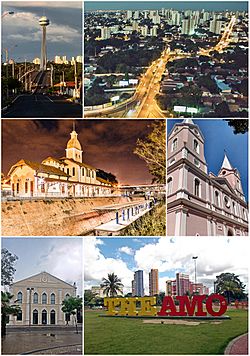
From the top: Estaiada Mirante bridge, Teresina at night, Railway station complex, Cathedral of Our Lady of Sorrows, September 4th Theater and tourist signboard
|
|||
|
|||
| Nickname(s):
Capital do Sol e da Luz (Capital of Sun and Light), Cidade Verde (Green City), Mesopotâmia Brasileira (Brazilian Mesopotamia) and THE.
|
|||
| Motto(s):
Omnia in Charitate
|
|||

Location of Teresina in the State of Piauí
|
|||
| Country | |||
| Region | Northeast | ||
| State | |||
| Founded | August 16, 1852 | ||
| Area | |||
| • Municipality | 1,167.25 km2 (450.68 sq mi) | ||
| • Urban | 1,755 km2 (677 sq mi) | ||
| Elevation | 87 m (285 ft) | ||
| Population
(2024)
|
|||
| • Municipality | 902,644 | ||
| • Density | 773.308/km2 (2,002.859/sq mi) | ||
| • Urban | 2,729,527 | ||
| • Metro | 2,893,729 | ||
| Demonym(s) | teresinense (teresenian) | ||
| Time zone | UTC-03:00 (BRT) | ||
| Postal code |
64000-001 to 64099-999
|
||
| Area code | +55 86 | ||
| HDI (2010) | 0.751 – high | ||
Teresina is the capital city of the Brazilian state of Piauí. It is the largest city in the state. Teresina is special because it's the only capital city in Brazil's Northeast region that is not on the Atlantic Ocean coast. It is located about 366 kilometers (227 miles) from the sea.
With over 900,000 people, Teresina is one of the biggest cities in Brazil. It forms a large city area with Timon, a city in the nearby state of Maranhão. The only natural thing separating Teresina from Timon is the Parnaíba River. This river is one of the largest in the Northeast of Brazil.
Teresina is known for having a good quality of life in its region. Its motto is a Latin phrase, Omnia in Charitate, which means "All for charity" in English. The city is also the birthplace of Torquato Neto, a famous artist from the Tropicalismo movement. The main church in the city is the Catedral Metropolitana Nossa Senhora das Dores, dedicated to Our Lady of Sorrows.
Contents
History of Teresina
Teresina was founded on August 16, 1852. It was first called Vila Nova do Poty. This name came from the Poti River, which is near the city. Teresina was the first city in Brazil that was planned before it was built. It was also the only capital city in the Northeast not on the coast.
Before Teresina, the capital of Piauí was a city called Oeiras. But it was hard to communicate and trade from Oeiras. So, the capital was moved to an area near the Parnaíba River. This made it easier to connect with other cities and the sea. The area where Teresina is now located started as a small fishing village in the 1700s. It was called "Vila do Poty." However, because the Parnaíba River would flood, the city had to be built on higher ground.
In the 1800s, the city's name was changed to Teresina. This was done to honor Empress Teresa Cristina. She was the wife of Emperor Pedro II of Brazil.
Teresina is known as one of the hottest cities in Brazil. It also has many lightning strikes. Today, Teresina's economy relies on factories that make things for other countries and on trade.
Cool Places to See
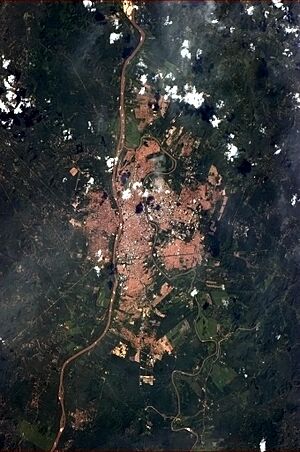
Teresina has many interesting places to visit:
- Casa da Cultura de Teresina: This place shows off the city's culture. It also hosts many cultural events.
- Centro Artesanal "Master Dezinho": Here you can find handmade crafts. Many are made from clay and have beautiful paintings.
- Teatro 4 de Setembro: This is a theater where you can watch shows, plays, and other performances.
- Mirante da Ponte Estaiada "João Isidoro França": This is a viewpoint on a bridge. You can get great views of the city from here.
- Encontro dos Rios: This is a natural spot where the Parnaíba and Poti rivers meet. It's a beautiful place to visit.
- Parque Zoobotânico: This is a zoo with animals typical of Brazil. It also has animals from other countries.
- Igreja de São Benedito: This is the main Catholic church in the city.
- Museu do Piaui: This museum has many items from the history of Teresina and Piauí. You can see old furniture, documents, and other interesting things.
Geography and Climate
Teresina is located on the east side of the Parnaíba River. It is right on the border with the state of Maranhão. The city is about 72 meters (236 feet) above sea level. Teresina faces the city of Timon across the river. It is also located between the Parnaíba River and another river called the Poti River. These two rivers meet at the northern end of the city. There is a park there where you can enjoy nature. Teresina is the largest capital city in the Northeast in terms of land area. It covers about 1,756 square kilometers (677 square miles).
Teresina is in a special area where the Northeast of Brazil meets the Amazon region. It is surrounded by different types of forests and open grasslands. You can see many kinds of palm trees and other medium-sized trees here. There are also parts of the Atlantic Forest in the region. This makes the plant life around Teresina very rich and thick.
Teresina's Weather
Teresina has a tropical wet and dry climate. This means it has two main seasons. There is a rainy season during summer and autumn. Then there is a dry season during winter and spring.
From January to May, it is hot and wet because of the rains. Sometimes there is fog in the morning. From June to August, the weather becomes dry. The nights are a bit cooler then. From September to December, it gets hotter, and the air becomes less humid. The rains slowly start to return in October. Locals call this period "Bro" because the hottest months in Portuguese end with "-bro" (like setembro, outubro, novembro, dezembro). The rains in Teresina can be very fast and strong. They often come with strong winds and a lot of lightning.
Teresina is hot for most of the year. The average temperature is around 27°C (81°F). The coolest it gets is about 20°C (68°F) in July. The hottest it gets is about 36°C (97°F) in October. The lowest temperature ever recorded was 11.9°C (53.4°F) in June. The highest temperature ever recorded was over 40°C (104°F) in October and November. Strong winds help to make these hot temperatures feel a bit better. The air quality in Teresina is usually good. However, during the driest time, the air can get dry, and there might be fires.
| Climate data for Teresina (1981–2010 normals, extremes 1961–2010) | |||||||||||||
|---|---|---|---|---|---|---|---|---|---|---|---|---|---|
| Month | Jan | Feb | Mar | Apr | May | Jun | Jul | Aug | Sep | Oct | Nov | Dec | Year |
| Record high °C (°F) | 38.4 (101.1) |
38.0 (100.4) |
39.6 (103.3) |
35.0 (95.0) |
35.8 (96.4) |
36.9 (98.4) |
37.6 (99.7) |
38.4 (101.1) |
39.6 (103.3) |
40.4 (104.7) |
40.8 (105.4) |
39.5 (103.1) |
40.8 (105.4) |
| Mean daily maximum °C (°F) | 32.5 (90.5) |
32.0 (89.6) |
31.9 (89.4) |
31.8 (89.2) |
32.2 (90.0) |
32.5 (90.5) |
33.6 (92.5) |
35.4 (95.7) |
36.6 (97.9) |
37.2 (99.0) |
36.2 (97.2) |
34.8 (94.6) |
33.9 (93.0) |
| Mean daily minimum °C (°F) | 22.8 (73.0) |
22.6 (72.7) |
22.8 (73.0) |
22.8 (73.0) |
22.6 (72.7) |
21.5 (70.7) |
20.8 (69.4) |
21.1 (70.0) |
22.1 (71.8) |
23.2 (73.8) |
23.6 (74.5) |
23.4 (74.1) |
22.4 (72.4) |
| Record low °C (°F) | 19.8 (67.6) |
20.0 (68.0) |
18.5 (65.3) |
19.0 (66.2) |
19.4 (66.9) |
11.9 (53.4) |
15.0 (59.0) |
15.6 (60.1) |
17.7 (63.9) |
18.0 (64.4) |
19.0 (66.2) |
18.4 (65.1) |
11.9 (53.4) |
| Average precipitation mm (inches) | 196.8 (7.75) |
239.1 (9.41) |
286.9 (11.30) |
265.7 (10.46) |
120.6 (4.75) |
14.7 (0.58) |
10.6 (0.42) |
12.1 (0.48) |
13.0 (0.51) |
19.5 (0.77) |
45.9 (1.81) |
100.1 (3.94) |
1,325 (52.18) |
| Average precipitation days (≥ 1.0 mm) | 11.8 | 13.7 | 18.8 | 16.6 | 9.6 | 2.3 | 1.6 | 1.4 | 1.8 | 2.2 | 3.8 | 7.2 | 90.8 |
| Average relative humidity (%) | 80.2 | 83.6 | 85.1 | 85.4 | 83.4 | 76.9 | 69.4 | 61.8 | 56.6 | 56.2 | 61.8 | 69.8 | 72.5 |
| Average dew point °C (°F) | 23.5 (74.3) |
23.8 (74.8) |
24.0 (75.2) |
24.3 (75.7) |
23.8 (74.8) |
22.3 (72.1) |
21.0 (69.8) |
20.4 (68.7) |
20.0 (68.0) |
20.7 (69.3) |
21.5 (70.7) |
22.5 (72.5) |
22.3 (72.2) |
| Mean monthly sunshine hours | 191.6 | 170.6 | 187.9 | 191.4 | 236.3 | 264.9 | 285.5 | 302.5 | 283.9 | 286.8 | 251.3 | 221.1 | 2,873.8 |
| Mean daily daylight hours | 12.4 | 12.3 | 12.1 | 12.0 | 11.9 | 11.8 | 11.9 | 12.0 | 12.1 | 12.2 | 12.4 | 12.4 | 12.1 |
| Average ultraviolet index | 7 | 6 | 7 | 7 | 7 | 7 | 7 | 7 | 7 | 7 | 7 | 7 | 7 |
| Source 1: NOAA | |||||||||||||
| Source 2: Brazilian National Institute of Meteorology (INMET) Weather atlas(Daylight-UV) | |||||||||||||
People and Culture
In 2022, about 866,300 people lived in Teresina.
Religions in Teresina
Religion in Teresina (2010) Catholicism (78.94%) Protestantism (13.34%) Jehovah's Witnesses (0.89%) Spiritism (0.85%) Other (0.74%) No religion (4.49%)
Most people in Teresina are Roman Catholic. In 2010, about 79% of the people were Catholic. About 13% were Protestants, and nearly 5% said they had no religion. There are also smaller groups like Jehovah's Witnesses and Spiritists.
Among Protestants, many belong to Pentecostal churches. The largest Pentecostal group is the Assemblies of God. There are also Baptists and Adventists in the city.
Education in Teresina
In high schools in Teresina, students learn English and Spanish. They also learn Portuguese, which is the official language of Brazil.
Universities and Colleges
Teresina has several universities and colleges:
- Universidade Federal do Piauí (UFPI)
- Universidade Estadual do Piauí (Uespi)
- Instituto Federal de Educação, Ciência e Tecnologia do Piauí (IFPI)
- Faculdade de Saúde, Ciências Humanas e Tecnológicas do Piauí (Faculdade Novafapi)
- Faculdade Integral Diferencial (Facid)
- Instituto Camilo Filho (ICF)
- Centro de Ensino Unificado de Teresina (CEUT)
- Faculdade das Atividades Empresariais de Teresina (FAETE)
Schools
Some well-known schools in Teresina include:
- Colégio Sagrado Coração de Jesus (founded in 1906)
- Instituto Dom Barreto (founded in 1944)
Economy of Teresina
Teresina's economy is very important for the state of Piauí. It makes up about 40% of the state's total economy. The city has a strong textile and clothing industry. This industry exports products to other regions and creates many jobs.
There are also factories that make bicycles, drinks, medicines, chemicals, furniture, and ceramics. The construction industry has grown very quickly in the last 15 years. This is because many new buildings have been built in the city.
Getting Around Teresina
Teresina has a train service called the Teresina Metro. It has nine different stations. There are also buses that help people travel around the city. The Teresina/Senador Petrônio Portella Airport opened in 1967. It is located north of the city, between the Parnaíba and Poty rivers.
Sports in Teresina
The Albertão Stadium is a large sports venue in Teresina. It can hold 60,000 people. Many sports events take place here, including soccer and athletics. There is also a smaller stadium called the Lindolfo Monteiro Stadium. It was opened in 1944 and was updated in 2008. It can hold 6,000 spectators.
Teresina has several football (soccer) teams. These include Flamengo-PI, River-PI, Tiradentes, and Piauí-PI. The city also has a rugby union club called Delta Rugby Clube. This club plays in Brazil's top women's rugby league.
See also
 In Spanish: Teresina para niños
In Spanish: Teresina para niños



